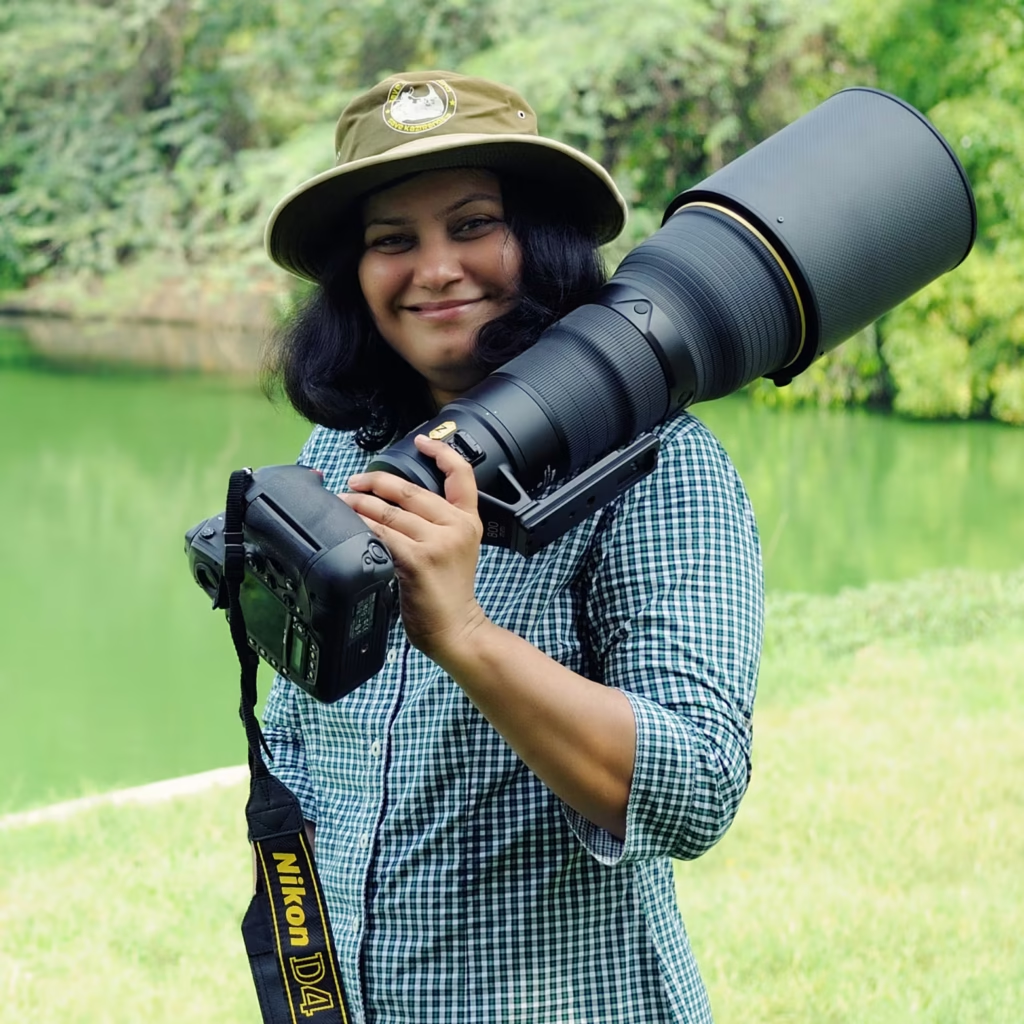Rathika Ramasamy
The Journey of Rathika Ramasamy: From Hobbyist to Wildlife Photography Icon

My interest in wildlife photography began in 2003 when digital cameras became available. In 2003, I visited the Bharatpur bird sanctuary for the first time. While observing the birds, I felt a strong desire to capture their images so I could enjoy looking back at them. Soon after, I purchased a large lens specifically for wildlife photography, and since then, there has been no turning back.
Now am based out of Chennai, doing wildlife photography for the last 21years. I specialise in wildlife and bird photography, and I love to shoot mammals like Elephant, and big cats too. I have been to most of the National parks in India and to the National parks in Africa.
The journey so far wonderful and my best thing about my work is ,out in the wild things change in minutes, anything could happen and being prepared to expect the unexpected is a big part of being out in nature. Every day is a new experience weaving a magical bond that only nature can create. Though I love to shoot in India, I started exploring south Asian countries for bird photography.
Being part of nature in the wild, encountering animals at close quarters and watching their life, waiting in the field while anticipating action to happen, and photographing them are all exciting. I believe wildlife photographers are their ambassadors; we get a chance to give voice to the voiceless wildlife animals and other species. Photographs can convey much more than words. Pictures of wildlife connect nature to people, and thereby help increase awareness about wildlife and its conservation. It is particularly important to spread this awareness among youth and children. Photographs depicting damages to the environment make common people sit up and take notice. It can help people understand how certain human activities can wreak havoc on natural habitats and on wildlife.
A. Respect for my subjects .My love, respect, and empathy for my subjects, combined with a deep understanding of their nature and history, enable me to capture their best wildlife moments. I always look for a story in the subjects and their behavioural interaction, and I love to capture action shots. I always try to convey the feelings I have when shooting a picture through my photographs. I try to capture them in best mood. Through my photography I try to bring nature close to viewers.
B. I am committed to consistently creating high-quality work. Keeping up the industry trend learning updating your technical knowledge and field knowledge.
C. Showcasing and promoting my work best way possible way utilising the technology. Creating brand from the early stages of my career, I have actively showcased my work on the internet through my website, photography forums, and social media platforms. I build and still I manage my website.
3. What are the most significant milestones you’ve achieved so far in your photography career?
I published many publications, and had participated many exhibitions.
A turning point in my journey came with the Clean Ganga Campaign. The project required me to travel to Varanasi for a week-long shoot, and my work was later exhibited at the India Habitat Centre. This experience shifted my perspective on wildlife photography. I began to see it through the lens of conservation and realized how photography could contribute to wildlife preservation.
Following this, another significant opportunity came when Jawaharlal Nehru University (JNU) invited me to photograph the birds on their campus for their 2007 university calendar. Although I was more accustomed to shooting in sanctuaries and national parks, I embraced this new challenge of capturing wildlife in the heart of the city. Within a month, I had photographed 150 different species of birds on the campus.
Since 2010, I regularly conducts wildlife photography master classes to nurture new talent and delivers talks to raise awareness about conservation. I have conducted over 150 wildlife photography workshops and conservation talks in schools and colleges.
2013,I received NPS(Nikon Professional Membership ).
Feb 2015 got “Inspiring Icon Award “ from the prestigious SathyabamaUniversity, Chennai. Same year received ICF The International Camera fair )award for the outstanding performance and achievements in wildlife photography. Year 2018, I was cited to be the best known woman photographer across the world on the internet.
- In February 2010, I published her first photo book on “Bird photography”.
- In November 20, 2014 I published my “The Best of Wildlife Moments”, photo book of wildlife moments from her collection.
- I have served on the jury panel for international photography contests such as the UN (United Nations) World Ocean Day, URBAN Photo Awards, BPOY (Bird Photography of the Year), and the Wiki Loves Earth photography contest.
- My name and my work is mentioned in the 10th standard science textbook of the Tamil Nadu Government state syllabus.
- 2021, I founded RR Foundation for Wildlife Conservation (RRFWC).
My love and Passion for birds and nature helps to continue to inspire in this field.
I have lot of patience for waiting for hrs in the forest for birds and animals.
As wildlife photographer needs to lot of patience and learn to enjoy nature. Sometimes I will be in the forest from morning till evening and not click anything. Wildlife animals ,we need to wait for them. Need lot of patience.
5. What obstacles did you have to overcome to get where you are now?
However, wildlife photography is a tough job. Physically demanding. There are a lot of practical constraints, such as extreme weather conditions, carrying weighty bags with camera and accessories, travelling to remote areas. Initially after one week shoot ,one week I took rest. My lens weight 5.5 kg with one more camera and back bag, min 10 kg I used carry. For bird photography one has to walk lot. Because of love for birds, all obstacles I could overcome.
Even after 21 years in the fields, I still feel wildlife photography in India is nascent. It is a huge challenge to get financial sustenance through wildlife photography. When starting, you may not able to get sufficient monetary rewards. It is not lucrative compared to other genres such as fashion or wedding photography.
Spend more time on the field to get field knowledge, read a lot about your subjects. Invest good equipment and create unique high quality work.Take this genre only if you love wildlife and nature. Create strong portfolio of work to start and follow ethics of wildlife photography. One has to stand out to be successful.
